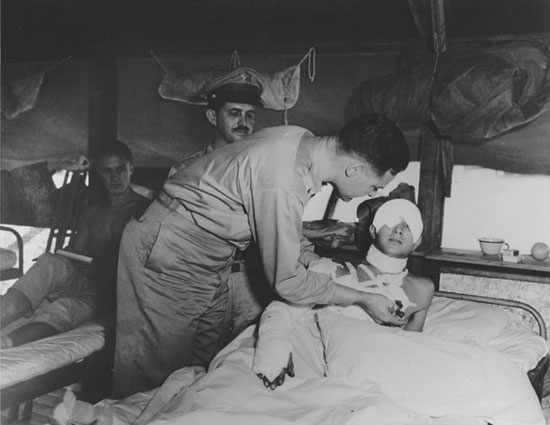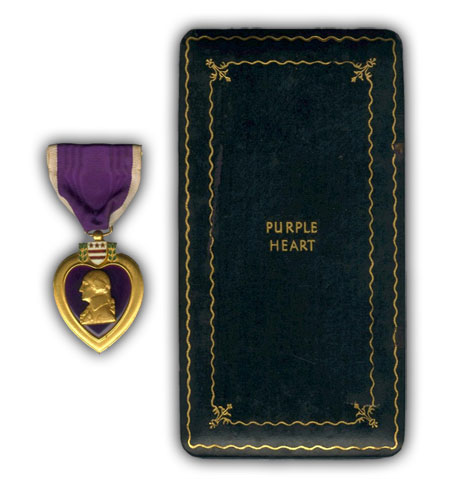The Purple Heart

Pfc Raymond F. Kavis (Harvey, Illinois), holds the “Purple Heart” awarded for wounds received in action. He was wounded when landing in French Morocco, 8 November 1942 (Operation “Torch”)
Introduction:
Battle casualties, are described as service personnel wounded and injured in action, and are based on all kinds of wounds and injuries received in action, whether there was a piercing or tearing of the body (as in penetrating wounds), or none (as in contused wounds), fractures, burns, blasts, concussions, etc., and also included those wounded or injured in action personnel requiring first aid, medical treatment, and hospitalization (also those who died of wounds or injuries, after reaching some type of medical treatment facility), they all were eligible for a “Purple Heart”.
All overseas Theaters initially reported battle casualties to The Adjutant General Office. Information was also received from the International Committee of the Red Cross (Geneva), the United States Legation in Berne, Switzerland, and other sources on American captured and interned personnel. The Casualty Branch, A.G.O., was the official casualty recording and notification agency of the War Department. It was primarily concerned with receipt and recording of basic reports on individual casualties, and the issuance of notifications to emergency addresses and to appropriate War Department agencies. From these reports the “Strength Accounting Branch”, AGO, prepared statistical cards on battle casualties and deaths and statistical tabulations and reports derived from them.

Senator Henry Cabot Lodge, Jr. awards the Purple Heart to a wounded soldier during a tour of the military hospital in Port Moresby, New Guinea, September 11, 1943. Senator Lodge resigned from the Senate in February 1944 to go on active duty in the U.S. Army.
Between December 7, 1941 > December 31, 1946, there were 592,170 wounded and injured in action (38,504 Off + 553,666 Enlisted), who in theory, rightly deserved a Purple Heart … for those of us who like figures, total official battle casualties amounted to 936,259 men and women (95,998 Off + 840,261 Enlisted).
Description:
WW2 AR 600-35 : on a purple enameled heart within a bronze border a profile head in relief of General George Washington in military uniform. Above the enameled heart, the shield of Washington’s Coat of Arms between two sprays of leaves in green enamel. On the reverse below the shield and leaves without enamel, a raised bronze heart with the inscription, “For Military Merit”, with a space for the name of the recipient (which is to be engraved). The entire device is 1 11/16 inches in length. The medal is suspended by a rectangular-shaped metal loop with corners rounded from a silk moiré ribbon 1 3/8 inches in width and 1 3/8 inches in length, consisting of a purple (pansy) center with 1/8-inch white edges.

Purple Heart ribbon with bronze Oak Leaf Cluster, designating a subsequent award.
WW2 AR 600-40 : Oak-Leaf Cluster : a bronze twig of four oak leaves with three acorns on the stem 13/32 of an inch in length. Bronze and/or silver.
Order of Precedence:
WW2 AR 600-40 : Distinguished Service Cross – Distinguished Service Medal – Legion of Merit – Silver Star – Distinguished Flying Cross – Soldier’s Medal – Bronze Star – Air Medal – Purple Heart – Good Conduct … (followed by Service Medals in order of the date of the Service performed).

Illustration of the Purple Heart with presentation case.
Background Information:
The original Purple Heart, designated “Badge of Military Merit”, was personally established by General George Washington, Commander-in-Chief of the Continental Army, August 7, 1782.
On October 10, 1927, Army Chief of Staff, General Charles P. Summerall directed that a draft bill be sent to Congress to revive the “Badge of Military Merit”. The bill was however withdrawn and all action on the case ceased on January 3, 1928. Nevertheless, The Adjutant General’s Office, was instructed to file all materials collected for possible future use.
During WW1, the “Purple Heart” was awarded in the name of the President of the United States to any member of the American Armed Forces who, while serving with the A.E.F. after April 5, 1917, had been wounded or killed, or died after being wounded.
During the early period of WW2 (December 7, 1941 > September 22, 1943), the “Purple Heart” was awarded both for wounds received in action against the enemy, and for meritorious performance of duty. With the establishment of the “Legion of Merit”, by an Act of Congress dated July 20, 1942, the practice of awarding the Purple Heart for meritorious service was discontinued! By Executive Order No. 9277 dated December 3, 1942, award of the “Purple Heart” was extended to apply to ALL Services and the Order required that Regulations of the Services be uniform in application as far as practicable. This Order also authorized the award only for wounds received.

Illustration of “Purple Heart” posthumously awarded to Pfc Jack J. Hertneky, Jr., ASN 37701765 (DOW in the MTO March 5, 1945).
A Purple Heart was authorized for the first wound suffered under conditions indicated above, and for each subsequent award an Oak Leaf Cluster was awarded to be worn on the suspension ribbon. Not more than ONE award could be made for more than one wound or injury received at the same instant or from the same missile, force, explosion, or agent (when more than five Bronze Oak Leaf Clusters were earned, a silver OLC was authorized for wear).
During World War 2 (but also in Korea and in Vietnam), the “Purple Heart” was often awarded on the spot, with occasional entries made into the Official Service Records, although this was more often not the case! It should be noted that, in addition to the above, a number of field commanders would sometimes engage in “bedside presentations” of the Medal. This would typically entail a local Commander or a General Officer entering a Hospital Ward with a box of Purple Hearts, pinning them on the chests or on the pillows of wounded servicemen, and then departing with no official records kept of the visit or of the awarded persons.
Posthumous awards were sent to the relatives or next-of-kin of a deceased member of the Armed Forces, who could then display the decoration in any manner desired, but were not authorized to wear it.
In normal conditions, all awards were to be officially recorded, and subsequently mentioned in the ‘Enlisted Record (Honorable Discharge)’, W.D., A.G.O. Form No. 55, October 10, 1939, under the heading ‘Decorations, Service Medals, Citations’, or in the following document; ‘Enlisted Record and Report of Separation – Honorable Discharge’, W.D., A.G.O. Form 53 – 55, 1 November 1944, heading 33 ‘Decorations and Citations’.
